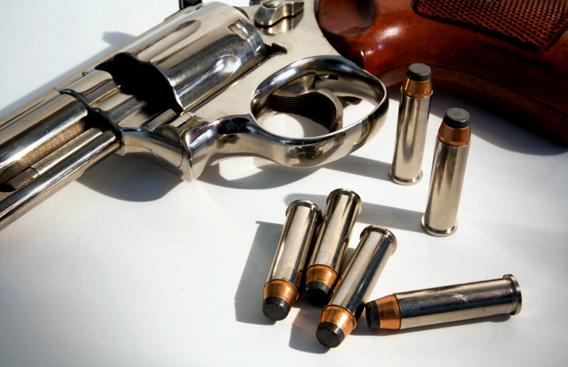Murder suspect and former Los Angeles police officer Christopher Dorner engaged police in a fierce gunfight on Tuesday, killing one officer and wounding another, before the mountain cabin that sheltered him burned to the ground. Police believe Dorner was killed in the fire. What’s the best strategy in a gunfight?
Draw first and fire while moving. Each gunfight has its own nuances, but they can be separated into two broad categories: brief shootouts and prolonged standoffs. The former is far more common, especially for law enforcement officers. NYPD firearms expert Frank McGee says the typical police gunfight conforms to a “rule of three:” three rounds, 3 yards, three seconds. Even that might be overstating the duration of the average shootout. Studies show that 85 percent of slain police officers are killed before firing a shot, and nearly 70 percent of gunfights take place over a distance of less than 2 yards. Under those circumstances, the rule of the Old West still applies: The faster draw usually wins. The officer may be able to anticipate the gunfight by keen observation. Many criminals look around for an escape route, grit their teeth, or take an aggressive stance a moment before deciding to fight. If an officer misses those signs and is beaten to the draw, he or she must respond by drawing a weapon quickly and presenting a moving target. Moving while shooting forces the perpetrator to change position or at least retake aim. (Most criminals are terrible shots.) If the shooter is within arm’s reach, it may be better to lunge before drawing. Knocking an opponent off balance might just prevent a shot before the officer can unholster his or her own gun.
The details of Tuesday’s deadly shootout in California are still somewhat sketchy, but it appears that Christopher Dorner reached the cabin before shooting a pair of San Bernardino County sheriff’s deputies. This shootout may have been an example of the less common standoff-style gunfight. Choosing cover appropriate to the suspect’s weapon is crucial in those situations. Powerful firearms, like those Dorner had, can splinter trees, penetrate steel doors, and crumble cinderblocks. One of the best barriers is a car’s engine block, which provides multiple layers of protection. Thin, soft, and hollow objects are to be avoided, but they’ll do if nothing else is available. They provide concealment, if not protection, and many suspects attempt to fire around obstacles they could easily shoot through. One other note that should go without saying but often doesn’t: The barrier is worthless if you don’t get behind it. In the heat of battle, officers sometimes inexplicably stand next to their cover.
Once officers have taken cover, they should maintain the offensive, especially against an inexperienced suspect. There’s a saying in sports that allowing an underdog to keep the game close gives him self-belief, and the same is true in a gunfight. Police often attempt to overwhelm their opponent with shots to demonstrate that he or she can’t match the training and firepower of a trained officer. Dorner, however, was no ordinary opponent. He served in the Navy, and LAPD trainers described him as an expert sharpshooter. His stated intent was to kill police officers. Under those circumstances, the best strategy is usually to stay down, contain the suspect, and stall until the SWAT-team arrives.
Although three-second gunfights are far more common and deadly, critics say too many police departments train only for standoff-style gunfights. With a perfect stance and time to use a pistol’s sight, the average officer can hit a stationary paper target more than 90 percent of the time. In a real-life shootout, however, accuracy drops to between 15 and 40 percent. That’s because, in crisis situations, officers square up to the target, bend their knees, fold slightly at the waist, and shoot without using the gun’s sight. Training-reform advocates argue that police should practice this imperfect shooting-style at the range, since it’s unavoidable in the field.
Got a question about today’s news? Ask the Explainer.
Explainer thanks Michael Rayburn of Rayburn Law Enforcement Training and Dave Spaulding of Handgun Combatives.
